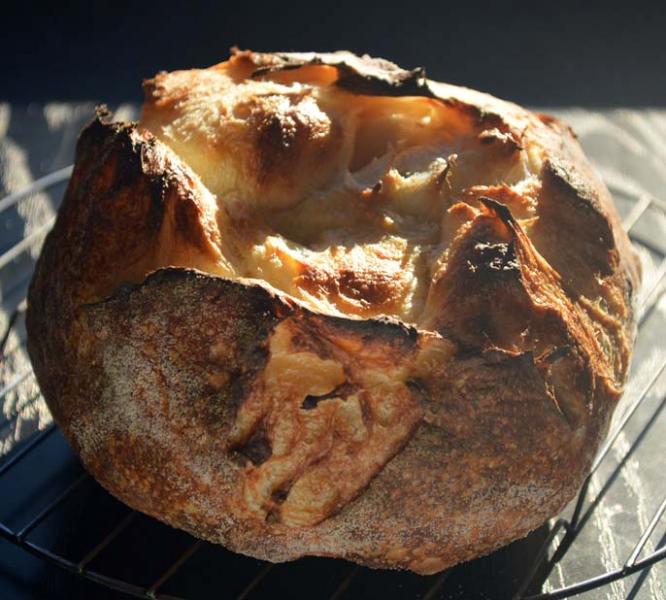Peter Reinhart's Multigrain Struan Bread
Reinhart's Crust and Crumb was one of the first baking books I bought. It introduced me to the basic concepts of bread baking. It was the first cookbook I had encountered that dealt with the science underlying the techniques described. Never mind that some of what Reinhart wrote in that book was not exactly correct, and some of his terminology was idiosyncratic. I didn't know better at that time, and the book inspired me to learn more and make breads I wouldn't have attempted otherwise.
All of Reinhart's books are personal in part, and I learned something about his history, including the role played in his life by some of the breads in Crust and Crumb. Among these was “Struan Bread,” which he developed when he had Brother Juniper's Bakery in Northern California. It was a best seller, was somewhat unique, and it helped establish him as a significant player in the “bread revolution.” Those who have made Struan Bread seem to enjoy it a lot. Many have written it is the best bread for toast they have ever had.
Somehow, I never got around to making Struan. I'm pretty sure this is because, in the version I first encountered in Crust and Crumb, Reinhart made much of the role played by leftover brown rice in the wonderful texture and flavor of this bread. I am not a brown rice fan. If Struan Bread required brown rice, it wasn't going to happen in my kitchen. On the other hand, his 100% Whole Wheat Bread became a favorite of mine and my wife's, and I made it quite often.
By time Reinhart wrote Whole Grain Breads (WGB), he had developed a 100% whole wheat version of Struan that was almost the same as his contemporaneous version of 100% Whole Wheat Bread. The newer version was also much more “permissive” about what cooked grains could be used. This weekend, I found myself with a bowl of leftover bulgur, and it occurred to me I could use it rather than brown rice in Struan Bread.
Now, Struan Bread is a multi-grain bread, but, in Reinhart's original formula, the main grain was bread flour. I have never made this version. I made the version in WGB which used all whole wheat flour. The other grains I used, besides bulgur, were polenta and rolled oats.

Struan, proofed and ready to score and bake

Struan baked and cooling

Struan cut profile & crumb

Struan crumb close-up
I followed Reinhart's instructions but found that the dough was very sloppy. I ended up adding about a quarter cup of flour during the mixing, and still ended up with a very loose, sticky dough – not what Reinhart described as slightly tacky. Rather than add yet more flour, I added a couple stretch and fold in the bowl episodes during bulk fermentation. By time the dough was ready to shape, it was still sticky, but easily managed with a light dusting of flour.
I searched TFL for members' blog entries on this bread after my loaf was out of the oven. I learned that the majority had baked earlier versions using bread flour, but several had baked the WGB version with whole wheat. Everyone who had, remarked on having to add significant amounts of flour to get a workable dough. I then went back and compared the versions of the Struan Bread formula in Crust and Crumb, The Bread Baker's Apprentice and Whole Grain Breads. I found that, in the earlier two books, Reinhart treated the cooked grain as a separate ingredient in the final dough, whereas in WGB it is included in the soaker. Reinhart's soaker consists of equal weights of water and grains, including the cooked grain. Thus, the cooked grain is, as it were, hydrated twice – once when it is cooked and again in the soaker. I think it is this change that accounts for the dough being so much wetter than the book says it should be. Why wasn't this caught in testing the recipes for the book? I don't know. If anyone else has a better and more complete explanation of this seemingly common issue with this formula, I would certainly like to hear it.
Reinhart's formula has a surprisingly high percentage of instant yeast, and I found that the dough expanded during bulk fermentation and proofing significantly faster than expected. In fact, by time I baked the loaf, it was so puffy, I was afraid I had over-proofed it, and it would collapse. So, I scored it very shallowly. Although it did not deflate, it had very little oven spring.
I sliced the loaf after it had cooled for about 2 hours. The crust was firm. The crumb was rather dense but reasonably well-aerated and moist. The flavor was complex and intense, with a strong whole wheat flavor and a strong honey background. My first impression was that this was a bread that one could make a meal out of, at least from a nutritional perspective. As expected, the flavors mellow and meld by the day after baking. It does make very good toast, but I believe I prefer Reinhart's “100% Whole Wheat Bread” to this whole wheat Struan. I plan on trying the “transitional” version of the Struan in WGB and, perhaps one of the earlier versions that got such wonderful reviews.
If I make this version again, I will 1) treat the cooked grains as Reinhart did in earlier versions of Struan, and 2) reduce the amount of instant yeast by a third to a half.
I think my wife would be perfectly happy if I just kept making this version. She loved it. This bread is so full of flavor and is so substantial, the versions with lesser proportions of whole grain flour may taste dull. We will see.
David
































